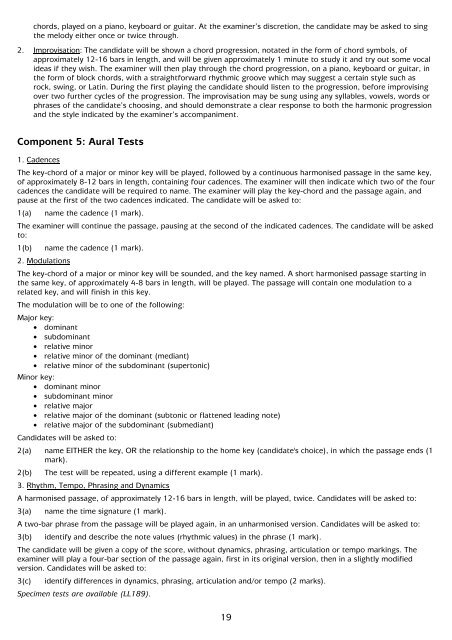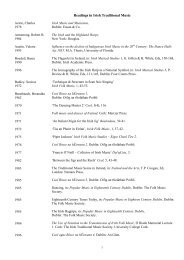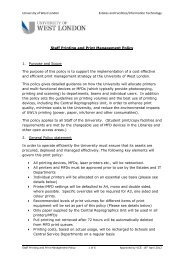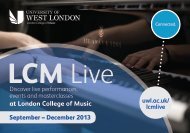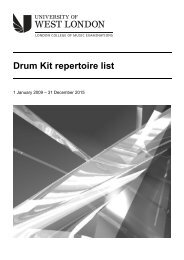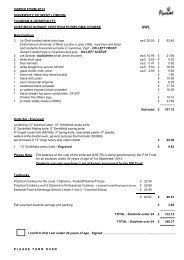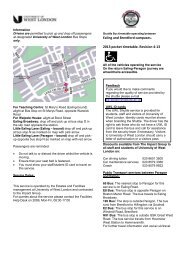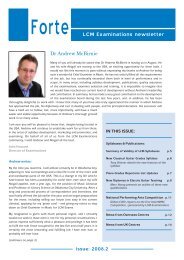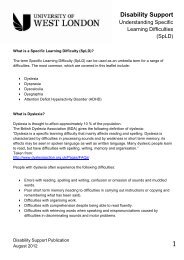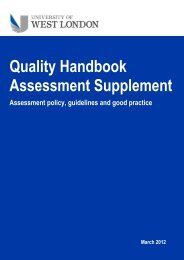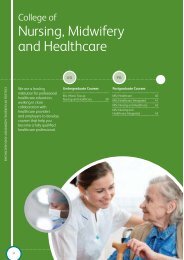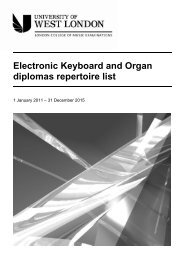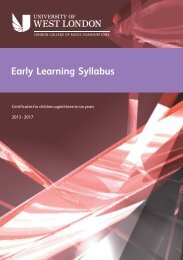LCM Exams - Church Music Diplomas - University of West London
LCM Exams - Church Music Diplomas - University of West London
LCM Exams - Church Music Diplomas - University of West London
- No tags were found...
Create successful ePaper yourself
Turn your PDF publications into a flip-book with our unique Google optimized e-Paper software.
chords, played on a piano, keyboard or guitar. At the examiner’s discretion, the candidate may be asked to singthe melody either once or twice through.2. Improvisation: The candidate will be shown a chord progression, notated in the form <strong>of</strong> chord symbols, <strong>of</strong>approximately 12-16 bars in length, and will be given approximately 1 minute to study it and try out some vocalideas if they wish. The examiner will then play through the chord progression, on a piano, keyboard or guitar, inthe form <strong>of</strong> block chords, with a straightforward rhythmic groove which may suggest a certain style such asrock, swing, or Latin. During the first playing the candidate should listen to the progression, before improvisingover two further cycles <strong>of</strong> the progression. The improvisation may be sung using any syllables, vowels, words orphrases <strong>of</strong> the candidate’s choosing, and should demonstrate a clear response to both the harmonic progressionand the style indicated by the examiner’s accompaniment.Component 5: Aural Tests1. CadencesThe key-chord <strong>of</strong> a major or minor key will be played, followed by a continuous harmonised passage in the same key,<strong>of</strong> approximately 8-12 bars in length, containing four cadences. The examiner will then indicate which two <strong>of</strong> the fourcadences the candidate will be required to name. The examiner will play the key-chord and the passage again, andpause at the first <strong>of</strong> the two cadences indicated. The candidate will be asked to:1(a) name the cadence (1 mark).The examiner will continue the passage, pausing at the second <strong>of</strong> the indicated cadences. The candidate will be askedto:1(b) name the cadence (1 mark).2. ModulationsThe key-chord <strong>of</strong> a major or minor key will be sounded, and the key named. A short harmonised passage starting inthe same key, <strong>of</strong> approximately 4-8 bars in length, will be played. The passage will contain one modulation to arelated key, and will finish in this key.The modulation will be to one <strong>of</strong> the following:Major key:• dominant• subdominant• relative minor• relative minor <strong>of</strong> the dominant (mediant)• relative minor <strong>of</strong> the subdominant (supertonic)Minor key:• dominant minor• subdominant minor• relative major• relative major <strong>of</strong> the dominant (subtonic or flattened leading note)• relative major <strong>of</strong> the subdominant (submediant)Candidates will be asked to:2(a) name EITHER the key, OR the relationship to the home key (candidate's choice), in which the passage ends (1mark).2(b) The test will be repeated, using a different example (1 mark).3. Rhythm, Tempo, Phrasing and DynamicsA harmonised passage, <strong>of</strong> approximately 12-16 bars in length, will be played, twice. Candidates will be asked to:3(a) name the time signature (1 mark).A two-bar phrase from the passage will be played again, in an unharmonised version. Candidates will be asked to:3(b) identify and describe the note values (rhythmic values) in the phrase (1 mark).The candidate will be given a copy <strong>of</strong> the score, without dynamics, phrasing, articulation or tempo markings. Theexaminer will play a four-bar section <strong>of</strong> the passage again, first in its original version, then in a slightly modifiedversion. Candidates will be asked to:3(c) identify differences in dynamics, phrasing, articulation and/or tempo (2 marks).Specimen tests are available (LL189).19


